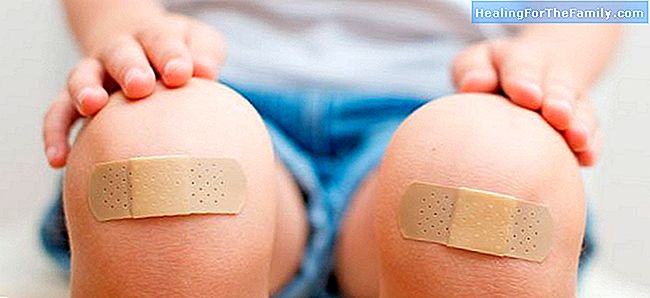The most common injuries of children
Children's injuries are, generally, the result of falls that cause aggressions in the skin and in the adjacent and subcutaneous tissues . Its importance or severity depends on how they were produced. The most frequent and least severe injuries are erosions, which are detachments of the superficial l
Children's injuries are, generally, the result of falls that cause aggressions in the skin and in the adjacent and subcutaneous tissues. Its importance or severity depends on how they were produced. The most frequent and least severe injuries are erosions, which are detachments of the superficial layers of the skin that expose small blood vessels, and consequently cause capillary hemorrhage.
In the erosion can be small fragments of the material with which the collision has occurred: grains of sand, asphalt or other. These wounds are typical of scraped knees or peeled elbows. In children, accidental falls are manifested, especially in the most prominent areas of the body such as the arms or legs.They are usually produced by sports durante, during games where it is necessary to run or during a bicycle ride or playing with the skateboard, the scooter or the skates without protectors.Cuts, scratches and scrapes of children
To care for a wound, one must first differentiate between

clean wounds que, which are those in which it is clearly observed whether or not there are foreign bodies or remnants of aggressive material, and dirty wounds, where we would place the rest. 1. Incised wound.We know them with the name of cut, and it is characterized by the sharp separation of the edges. It is the typical wound produced by a broken glass or the edge of a can. These wounds tend to produce hemorrhages, because the object that penetrates the skin opens the blood vessels it finds. One of the problems that these injuries can present is that they can affect other structures besides the skin, such as tendons, muscles or nerves
2. Erosions. They are the most frequent injuries in children and also the least serious ones. They are detachments of the superficial layers of the skin that expose blood vessels of small caliber, and as a consequence they produce a capillary hemorrhage.
A common danger of wounds: infection The opening of the skin facilitates
the penetration of microorganisms
, and the causal object itself may be contaminated by germs that leak under the skin at the same time of the blow or trauma. When the wound is not too dirty and is properly cured with careful washing and the application of antiseptics, it is possible that it does not cause more problems. If infection does not occur,the wound heals the new tissue grows and the fibers that unite the two edges are formed
. The healing time is usually one week. Depending on the type of skin, there may be a mark or a scar. However, when it becomes infected, inflamación inflammation of the areamay occur, which increases in volume, becomes very red and hurts. The accumulation of cells of the immune system and dead microorganisms leads to the formation of pus, a milky and foul-smelling segregation that oozes from the wound.
Tetanus wound infection One of the greatest complications that can occur is infection by tetanus, an infectious disease for which there is a vaccine and which is caused by the bacterium Clostridium tetanicauses very serious disorders of nerve functions
This bacterium can be found in many places, such as soil, plant thorns or needles, irons or objects that can easily penetrate the skin.
If the tetanus bacillus penetrates the skin, it can reproduce inside it and elaborate a toxin that extends to the rest of the organism, especially to the nerves, and that acts on the muscular contractions, so that it can cause the rigidity of various parts of the body.
The best way to avoid it is to administer the tetanus vaccine regularly, which is now routinely administered to all children, within the childhood vaccination programs. Adults should be vaccinated again every 10 years. If you have not done so, after having a wound you should receive a dose of the tetanus vaccine.












